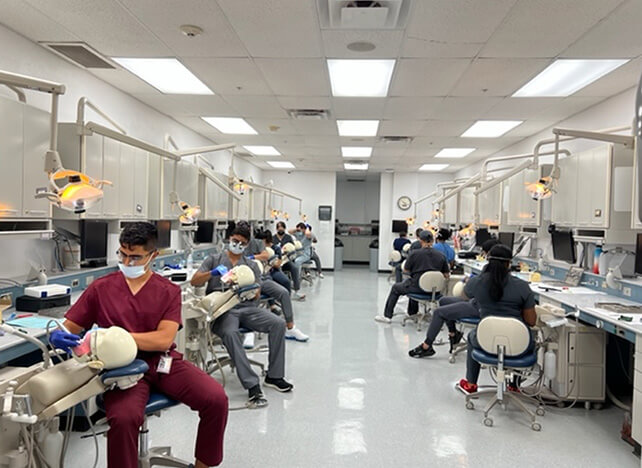The new academic year has kicked off, but several students have been on campus for most of the summer. From clinical outreach to scientific research, doctoral and dental hygiene students kept a full schedule. The Learning Enhancement for Achievement in Dentistry (LEAD) program is unique among the school’s summer offerings in that it is open to dental and predental students.
Senior dental student, Sofia J. Reyes, has participated in the LEAD program for the past seven years, starting the summer after her first year of college.
“I can confidently say my time in the program has strengthened my love for dentistry and my desire to give back to my community,” she said.
LEAD was established in the School of Dentistry in 2013 by Juanita Lozano-Pineda, DDS, MPH, program director. She and her team have been thoughtfully connecting dental and predental students with educational resources, assisting them academically, clinically, and even with their well-being.
The goal of the program has been to provide a seven-year pathway of experiences leading to academic success in the pursuit of dentistry. LEAD programs 1-3 focus on helping undergraduate college students prepare for the Dental Admission Test and the Texas dental school application process. Content such as gross anatomy case studies, typodont prep labs, mock admission interviews and application workshops provide future applicants access to dental facilities, faculty and, most popular, current dental students.
For LEAD 4-7, enrolled dental students engage in a three-week curriculum to prepare participants for the academic year ahead. Students can interact with faculty as they preview upcoming course material, treat patients at community clinics and discover how to properly care for their physical and mental well-being with a demanding school schedule.
The LEAD pathway has instituted a pipeline, bridging hopeful predental students with their career goal of becoming an oral health care professional. An intentional aim of the program has also been to become a guide for first-generation college students and those with an economically or academically disadvantaged background. Often, individuals with these backgrounds identify as an ethnicity that is underrepresented in the profession, such as Black and Hispanic students and Native Americans.
This is a critical group to connect with, said Lozano-Pineda.
“They are more likely to practice where dental services are in short supply and more likely to practice with high percentages of underrepresented racial and ethnic populations,” she said. “Encouraging them into the profession, leads to increased access to quality oral health care and reduced health disparities. The shared cultural beliefs with their patients, also allow for better communication and improved oral health with higher patient satisfaction.”
In a 2020 report by the American Dental Association’s Health Policy Institute, the state of Texas had 48.7 dentists for every 100,000 Texans, 20% below the national average of 60.9 dentists. The South Texas border region was 68% lower than the national average, with only 19.6 dentists per capita.
“The School of Dentistry has trained many of the current general and specialty dentists practicing in South Texas,” Lozano-Pineda said. “A 2021 study of all Texas dental school graduates found that 49% of those providing oral health care in the South Texas Border Region are our graduates.”
Reyes, a South Texas border native, appreciates her training and her new ability to contribute to the oral health of her hometown.
“I remember beginning with tutoring sessions to improve my hand skills in the simulation lab; fast-forward a few years, and I am now able to provide dental care to persons experiencing homelessness in my own community of Laredo through the program,” she said. “I will forever be grateful for this program helping me become who I am today.”
LEAD may have ended for this year, but the work of connecting with students endures.
“While recruitment efforts have led to an increase in the number of Hispanic dentists practicing in South Texas counties, the need is so great that many South Texas Border counties continue to be designated dental Health Professional Shortage Areas (HPSA),” Lozano-Pineda said.
“Demand for dental providers in these underserved counties is expected to increase because 29% of the dentists practicing in these HPSAs will be of retirement age in the next ten years. Therefore, pipeline efforts to recruit and mentor students from the region must continue to successfully train in dental careers.”


